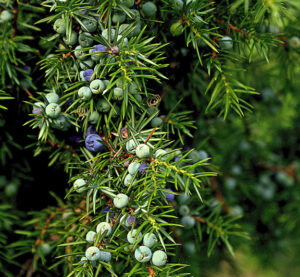Gin – juniper and ?
By Clive Larkman
When it comes to food and drink, like many other items in daily life, we are dictated by fashion and trends. Currently, we are in the middle of a boom in gin distillation. This has replaced the mass development of boutique, artisan or small batch breweries. It seems that there are as many gin distilleries as there are wineries in the traditional wine growing regions. I am not quite sure why, as there are very few distillers that grow their own inputs, and thus could be anywhere.
Gin has been in production since the eleventh century when the Benedictine monks were using it as a medicinal product. This arose from mixing juniper berries with wine in an area where Juniper communis dominated the landscape. The aim was to make a juniper-based medicine rather than an alcoholic drink. Juniper had been used as a medicinal plant since Roman times in Europe, and by native people of western USA. It is one of the most widespread tree species in the world.
During the 17th century, gin was a mix of juniper and a range of different alcohols – wine, beer and spirits. It was in the 18th century that it became a popular drink amongst the people. This arose out of social standing, price and restrictions on other forms of alcohol. It was easy to produce, and often mixed with other chemicals like turpentine and sulphuric acid. This kept the price down and made it quite accessible. Like just about everything enjoyable, the governments of Europe started taxing gin which of course resulted in a black-market industry.
Once people were able to make simple and effective stills that produced a clean and pure alcohol, the popularity of drinks like gin and vodka took off. From the mid-19th century to late 20th century, gin became a standard drink for large parts of the western world. It was the use of gin by people in the British colonies, to help with the fight against malaria, that made it a drink of both the common and elite layers of society. I am not sure whether the gin was added to the drink made of bitter quinine palatable, or the quinine was added to the gin as an easy way to consume it. It doesn’t really matter, as gin and tonic became one of the standard drinks in bars around the world.
Due to the complexity of flavours and the dryness of the drink, gin became the key ingredient in numerous popular cocktails. It was also found to be excellent as a carrier of other complex flavours resulting in Sloe Gin, Pink Gin and several others. Some say there are five, and others say seven, distinct types of gin – mostly based on where it is made. The noticeable differences are either the level of sweetness or the strength of the alcohol.
Of course, our world can never be simple and we have to deal with government interference and regulation. The 21st century has seen an explosion of gin distilleries around the world which has prompted the legal definitions of the various types of gin. The nations that consume gin all have their own rules about what is a gin and what forms each type of gin. There is one consistent rule, and that is the presence of juniper flavour, either direct by distilling the juniper or distilling in the presence of juniper berries. In the new world of gin production the distilled product has been blended with a huge range of botanical flavours. The range is extensive, from simple citrus notes, to rare and localised native flowers.
The majority of all juniper berries come from the natural habitats of southern and eastern Europe. There are some farms in the UK and the USA, but not many. In Australia there are a few small farms that produce juniper berries – mainly for their own consumption. The ‘berry’ is the female seed cone produced by several species of Juniper. As junipers are conifers, which do not have flowers, they don’t produce true berries. The ‘berry’ is a cone with fleshy and merged scales that look like a small berry, and when fertile carry a small non-winged seed. The berries from a few species are used as spices in various cuisines and of course, to make gin what it is.
Unlike other conifers, junipers are dioecious, meaning the plant has separate male and female flowers. In this case, both a male and female tree is required to produce seeds. The male tree has yellow flowers, while the female flowers appear as small clusters of scales that mature over 18 months or more into the ‘berries’. The female plants will ‘fruit’ without male plants present but will not produce viable seed. They will also produce more fruit if there are male plants present.
The gin juniper is Juniperus communis ssp. communis which naturally comes from central and southern Europe. The species is found in a wide latitude band from across the whole northern hemisphere, although the variants or subspecies differ from continent to continent. They are slow-growing scrappy plants that range from 40cm to 12m in height. The male plant is more upright and even messier in form. There are multiple cultivars and hybrids that look a lot nicer in the garden but don’t produce the ‘berries’.
Main photo: Juniper berries (Image: Bronislaw Drozka, Pixabay)

